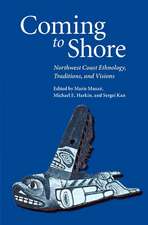Sharing Our Knowledge: The Tlingit and Their Coastal Neighbors
Editat de Sergei A. Kan, Steve Henriksonen Limba Engleză Paperback – dec 2023
This volume focuses on the preservation and dissemination of Tlingit language, traditional cultural knowledge, and history from an activist Tlingit perspective. Sharing Our Knowledge also highlights a variety of collaborations between Native groups and individuals and non-Native researchers, emphasizing a long history of respectful, cooperative, and productive working relations aimed at recording and transmitting cultural knowledge for tribal use and promoting Native agency in preserving heritage. By focusing on these collaborations, the contributors demonstrate how such alliances have benefited the Tlingit and neighboring groups in preserving and protecting their heritage while advancing scholarship at the same time.
| Toate formatele și edițiile | Preț | Express |
|---|---|---|
| Paperback (1) | 337.40 lei 6-8 săpt. | |
| Nebraska – dec 2023 | 337.40 lei 6-8 săpt. | |
| Hardback (1) | 476.92 lei 6-8 săpt. | |
| Nebraska – mar 2015 | 476.92 lei 6-8 săpt. |
Preț: 337.40 lei
Nou
Puncte Express: 506
Preț estimativ în valută:
64.57€ • 67.16$ • 53.31£
64.57€ • 67.16$ • 53.31£
Carte tipărită la comandă
Livrare economică 15-29 aprilie
Preluare comenzi: 021 569.72.76
Specificații
ISBN-13: 9781496236883
ISBN-10: 1496236882
Pagini: 542
Ilustrații: 118 photographs, 17 illustrations, 5 maps, 4 tables, 1 appendix, index
Dimensiuni: 152 x 229 x 35 mm
Greutate: 0.79 kg
Editura: Nebraska
Colecția University of Nebraska Press
Locul publicării:United States
ISBN-10: 1496236882
Pagini: 542
Ilustrații: 118 photographs, 17 illustrations, 5 maps, 4 tables, 1 appendix, index
Dimensiuni: 152 x 229 x 35 mm
Greutate: 0.79 kg
Editura: Nebraska
Colecția University of Nebraska Press
Locul publicării:United States
Notă biografică
Sergei Kan is a professor of anthropology at Dartmouth College. He is the editor and author of several books, including Russian American Photographer in Tlingit Country: Vincent Soboleff in Alaska; Memory Eternal: Tlingit Culture and Russian Orthodox Christianity through Two Centuries; and Symbolic Immortality: Tlingit Potlatch of the Nineteenth Century. Kan visits southeastern Alaska regularly and has been actively involved in organizing periodic Tlingit clan conferences. Steve Henrikson is a curator of collections at the Alaska State Museum and is an adjunct instructor at the University of Alaska Southeast in Juneau. He specializes in Tlingit material culture and art. Henrikson has lived in Juneau, Alaska, for many years.
Cuprins
List of Illustrations
Introduction
Sergei Kan
Part 1. Our Elders and Teachers
1. Shotridge in Philadelphia: Representing Native Alaskan Peoples to East Coast Audiences
Robert W. Preucel
2. Louis Shotridge: Preserver of Tlingit History and Culture
Lucy Fowler Williams
3. This Is Kuxaankutaan’s (Dr. Frederica de Laguna’s) Song
Chew Shaa (Elaine Abraham) and Daxootsu (Judith Ramos)
4. Mark Jacobs Jr./Gusht’ei’héen (1923–2005)
Harold Jacobs
5. X’eigaa Kaa (Tlingit Warrior)
Harold Jacobs
6. Mark Jacobs Jr./Gusht’eihéen: My Teacher, Friend, and Older Brother
Sergei Kan
7. World War II Scuttlebutt: Naval Section Bases, Southeast Alaska
Mark Jacobs Jr.
8. Poems by Andrew Hope III
Introduced by Ishmael Hope
9. As Long as the Work Gets Done
Peter Metcalfe
10. Revival and Survival: Two Lifetimes in Tlingit
Nora Marks Dauenhauer and Richard Dauenhauer
Part 2. Native History
11. Tlingit Interaction with Other Native Alaskan and Northwest Coast Ethnic Groups before and during the Russian Era
Elena Piterskaya
12. Relating Deep Genealogies, Traditional History, and Early Documentary Records in Southeast Alaska: Questions, Problems, and Progress
Judith Berman
13. Whose Justice? Traditional Tlingit Law and the Deady Code
Diane Purvis
14. Bringing to Light a Counternarrative of Our History: B. A. Haldane, Nineteenth-Century Tsimshian Photographer
Mique’l Icesis Dangeli
Part 3. Subsistence, Natural Resources, and Ethnogeography
15. Haida and Tlingit Use of Seabirds from the Forrester Islands, Southeast Alaska
Madonna L. Moss
16. Deiki Noow: Tlingit Cultural Heritage in the Hazy Islands
Steve J. Langdon
17. Place as Education’s Source
Thomas F. Thornton
Part 4. Material Culture, Art, and Tourism
18. Skidegate Haida House Models
Robin K. Wright
19. The Evolution of Tlingit Daggers
Ashley Verplank McClelland
20. Tourists and Collectors: The New Market for Tlingit and Haida Jewelry at the Turn of the Century
Kathryn Bunn-Marcuse
21. Opening the Drawer: Unpacking Tlingit Beadwork in Museum Collections and Beyond
Megan A. Smetzer
22. Balancing Protocol and Law for Intellectual Property: Examples and Ethical Dilemmas from the Northwest Coast Art Market
Alexis C. Bunten
Part 5. Repatriation
23. A Killer Whale Comes Home: Neil Kúxdei woogoot, Kéet S’aaxw, Mark Jacobs Jr., and the Repatriation of a Clan Crest Hat from the Smithsonian Institution
R. Eric Hollinger and Harold Jacobs
24. Building New Relationships with Tlingit Clans: Potlatch Loans, NAGPRA, and the Penn Museum
Stacey O. Espenlaub
Appendix
Contributors
Index
Recenzii
"Sharing Our Knowledge is a welcome reassessment of the field of Tlingit studies, but it is also far more than that, since it breaks new ground on so many different fronts, particularly its approach to collaborative and community-based research."—David Arnold, American Indian Culture and Research Journal
“A number of quite moving contributions. . . . Typically, the more interesting a book is, the more tangents are available to readers. This book sent this reviewer on numerous tangents. Highly Recommended.”—M. Ebert, Choice
"A necessary read for anybody living in Tlingit territory."—Michael Bach, Alaska Journal of Anthropology
"A welcome and unreservedly recommended addition to personal, professional, community, and college/university Native American Studies collections and supplemental Indigenous Anthropology curriculum studies lists."—Midwest Book Review
Descriere
Sharing Our Knowledge brings together Native elders, tradition bearers, educators, cultural activists, anthropologists, linguists, historians, and museum professionals to explore the culture, history, and language of the Tlingit people of southeast Alaska and their coastal neighbors.
























